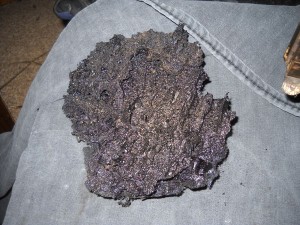One of the leading causes of chimney fires, according to the Chimney Safety Institute of America (CSIA), creosote build-up is a dangerous fact of life when you have a wood-burning fireplace or stove. Removing creosote deposits from your chimney walls plays a big role in your annual chimney sweeping. This maintenance task can save you and your family’s life as creosote building up on your chimney walls puts you at risk of a chimney fire. The chimney sweeps at The Mad Hatter will clean your chimney thoroughly to remove any creosote sticking to your chimney walls. We would like to answer some of the most frequently asked questions we receive about creosote to inform you about this fire hazard and its dangers.
What exactly is creosote and how does it build up in my chimney?
Forming naturally, creosote is the resulting residue of the condensation that occurs when the by-products of combustion (smoke, gases, vapors, unburned wood particles, tar fog, and other assorted minerals) leave the fireplace or wood stove and exit the cooler upper chimney. This residue sticks behind on the chimney walls.
What does creosote look like?
Varying in appearance, creosote can be either black or brown, and it takes different forms: sticky and tar-like, flat and shiny, and crusty and flaky. It can even develop into a hardened glaze that is very flammable. No matter what it looks like, creosote is highly combustible in every form.
How do creosote deposits start chimney fires?
If the build-up is large enough and your internal chimney flue temperature gets hot enough, a chimney fire could ignite, thanks to the highly combustible makeup of creosote.
Are there conditions that encourage the development of creosote deposits?
Yes, certain things to help creosote to build up more quickly: restricted airflow, burning unseasoned wood, and cooler than normal chimney temperatures.
What can I do to change these conditions?
To keep air flowing properly and without restrictions, open the glass fireplace doors when burning a fire, and always be sure your damper is wide open when burning a fire. You want to be sure you have enough air flowing into your fireplace to move heated smoke up the chimney quickly because the longer the smoke stays in the flue, the more likely creosote will form. When using a wood stove, do not close down the stove damper or air inlets too soon or too much. Always use seasoned firewood because burning unseasoned wood keeps the smoke cooler because the fire spends so much time burning off the excess water in the wood cells. Also, when using a wood stove, never overload the firebox with wood in an attempt to get a longer burn time because this also adds to creosote development.
What is the best way to prevent the accumulation of large creosote deposits?
As the CSIA says, “clean chimneys don’t catch fire.” Having your chimney swept annually by The Mad Hatter is the best possible prevention of creosote building up large enough to ignite a chimney fire. Our chimney sweeps are well experienced with creosote removal, and can rid your chimney walls of all creosote deposits.
If you have more questions about creosote and chimney fires, contact The Mad Hatter today. We will be happy to schedule an appointment for your annual chimney cleaning to give yourself peace of mind regarding a possible chimney fire.

